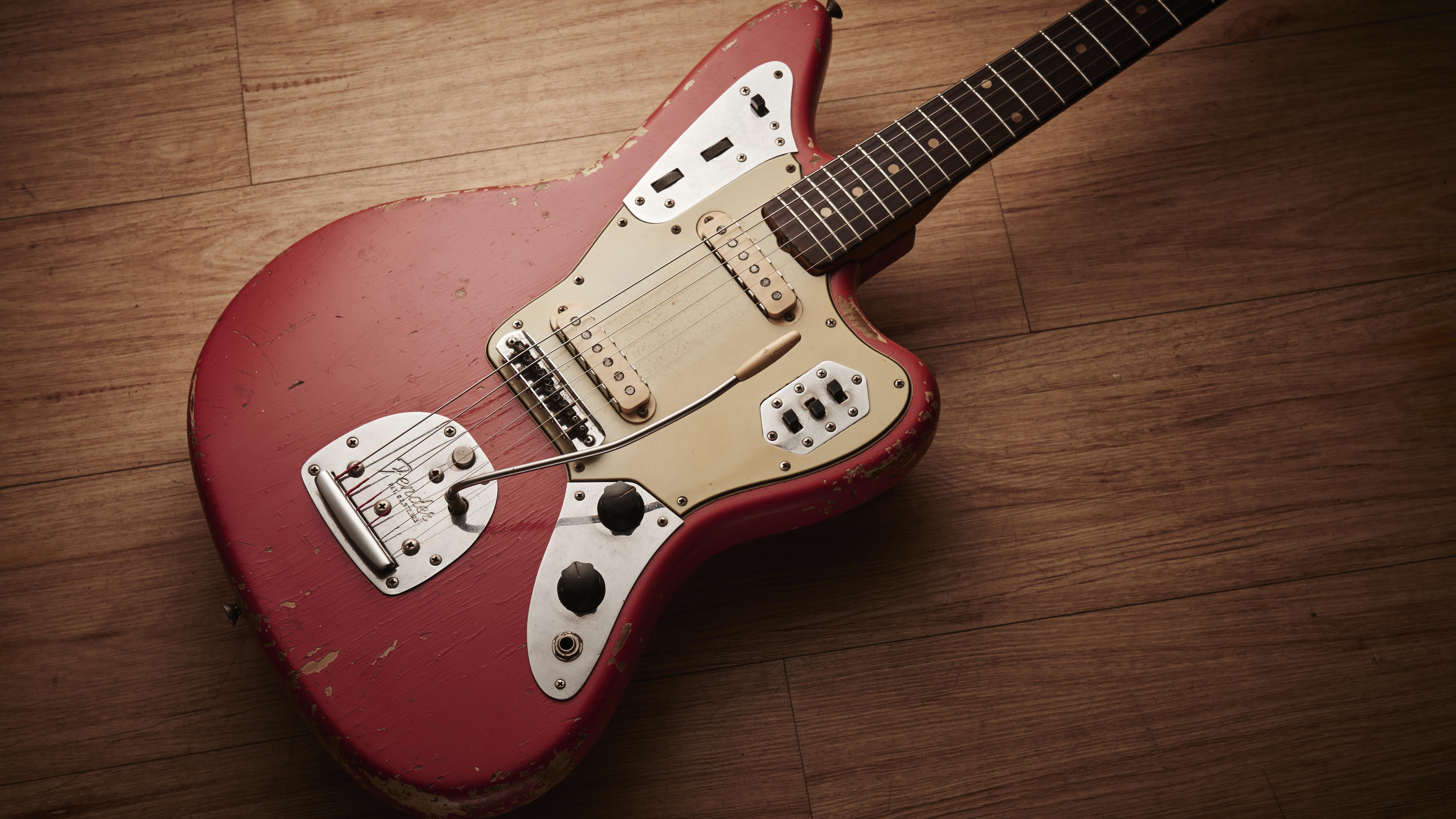Classic gear: Fender Jaguar
The story of the Big F's big cat

ELECTRIC GUITAR WEEK: Riding the wave of 60s surf, the Jag topped Fender’s big-game guitars…
Appearing in music stores in a striking range of custom colours in addition to the regular Sunburst finish, Jaguars first arrived in mid-1962 and topped the price list of Fender’s solidbody electric guitar line at $379.50 - a major difference in cost at the time when compared with its $259.50 Stratocaster and $209.50 Telecaster.
But Strats and Teles were the popular choice behind the burgeoning rock music scene of the mid to late 60s as far as Fenders go, and the Jaguar subsequently fell into relative obscurity. Jaguars did, however, prove to be a popular choice for surf musicians in the early 60s - The Beach Boys’ Carl Wilson being one notable player - and were generally marketed in order to appeal to the younger and apparently more adventurous generation.
Early advertisements for the Jaguar show some impressive, albeit eye-watering, double tasking: one man is pictured playing a Jaguar while riding a surfboard, and another ad depicts a motocross rider in mid-air with a Jag strapped to his back!
Electric Guitar Week is brought to you in association with Fender. Check out the Electric Guitar Week hub page for more tips and tutorials.
The Jaguar fell so far out of favour during the 60s and early 70s that in 1975 Fender discontinued it altogether
Although inheriting some obvious similarities from Fender’s second most expensive guitar at the time, the Jazzmaster (priced at $349.50), such as the ‘tremolo’ system and an offset body shape, Jaguars are markedly different in terms of sound and feel. Their 24-inch scale length - as opposed to the Jazzmaster’s 25.5-inch scale length - is, in fact, more similar to Gibson’s electric guitars.
A bridge mute assembly installed on Jaguars as standard (although rarely used because it offered little control and often detuned the guitar) further sets the two instruments apart, while the Jaguar’s unique ‘saw-tooth’ pickups produce a distinctively thinner, brighter and characteristically detailed tone. A ‘strangle’ switch located next to the pickup on/off switches on the control panel of the upper treble bout thins out the sound by way of engaging a capacitor/filter.
Get the MusicRadar Newsletter
Want all the hottest music and gear news, reviews, deals, features and more, direct to your inbox? Sign up here.
The Jaguar’s ‘lead’ and ‘rhythm’ circuit controls are spread across three chrome panels and might appear somewhat busy or confusing at first, but they may simply be thought of as a means to instantly swap between the different volume and tone settings of the front pickup: the back pickup is disabled in ‘rhythm’ mode, and in ‘lead’ mode the ability to switch both pickups on or off independently is activated (with ‘strangle’ switch engage optional).
The Jaguar fell so far out of favour during the 60s and early 70s that in 1975 Fender discontinued it altogether. However, it became a guitar of choice for many, often leftfield players who later discovered its charms (including their relatively low price!) on the vintage market. Following the Jaguar’s abandonment, Fender has since reintroduced its former flagship on several occasions due to an ever increasing demand, thanks in part to such notable guitarists as Marc Ribot, Tom Verlaine, Johnny Marr, Kurt Cobain and John Frusciante. Even Jimi Hendrix was known to strap on a Jag occasionally!
Nowadays, it seems as if there is a Jaguar for everyone with Fender currently offering the guitar in a wide variety of pickup configurations and colour options across its Custom Shop, American Professional, American Vintage, Artist, Classic and Squier ranges.
1962 ‘Green Sparkle’ Fender Jaguar

1. Serial number
Consisted of five digits stamped into the neckplate
2. Headstock
Flared, matching headstock; solid black ‘Jaguar’ logo, redesigned Fender logo and ‘Offset contour body’ decal; single string tree
3. Plastics
Three-ply tortoiseshell celluloid pickguard; foam mute; ‘lead’ circuit controls on treble side: volume and tone knobs with independent pickup on/off and ‘strangle’ switches; ‘rhythm’ circuit controls on bass side: circuit selection switch (metal ‘rhythm’ circuit volume and tone roller knobs); white vinyl pickup covers
4. Hardware
Single line Deluxe Kluson tuners; ‘PAT # 2,972,923’ floating vibrato/’tremolo’ system; ‘Fender Mute’ engraved mute control; adjustable sixsaddle bridge; three chrome control panels
5. Pickups
Two Stratocaster-sized pickups with saw-tooth chrome pickup cradles (concentrates magnet field underneath string and reduces interference)
6. Body
Solid alder body with Jazzmaster-style offset shape; ultra-rare ‘Green Sparkle’ finish (with matching headstock)
7. Neck
Bolt-on one-piece maple neck with thick Brazilian rosewood ‘slab’ fretboard and ‘clay’ dot markers; adjustable truss rod
The Evolution Of The Fender Jaguar
- Mid 1962: Jaguar introduced with thick ‘slab’ Brazilian rosewood fretboard, ‘clay’ dot inlays and flat pickup polepieces
- August 1962: Veneer Brazilian rosewood fretboard
- 1964: Staggered pickup polepieces
- 1965: Bound fretboard and pearloid dot inlays
- 1966: Block fretboard inlays
- 1967: Kluson Deluxe branded tuners change to F-style and headstock Fender logo changes from black and gold to solid black
- 1968: Nitrocellulose finish changes to polyester
- 1975: Discontinued
- 1986: Japanese ’62 reissue introduced
- 1999: American ’62 reissue introduced
Electric Guitar Week is brought to you in association with Fender. Check out the Electric Guitar Week hub page for more tips and tutorials.
Rod Brakes is a music journalist with an expertise in guitars. Having spent many years at the coalface as a guitar dealer and tech, Rod's more recent work as a writer covering artists, industry pros and gear includes contributions for leading publications and websites such as Guitarist, Total Guitar, Guitar World, Guitar Player and MusicRadar in addition to specialist music books, blogs and social media. He is also a lifelong musician.
“To be honest, I feel like I am playing a high-end Gibson guitar”: Epiphone and Guitar Center team up for a colourful riff on a cult classic with the limited edition run Les Paul Custom Widow
“The humbuckers give it so much power and such a wide variety of tones while the destruct button really sets it apart from just about any other Tele”: Fender unveils the Mike Campbell “Red Dog” Telecaster












